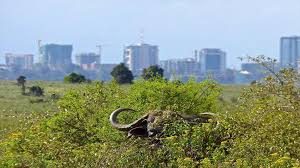GALLERY
NAIROBI NATIONAL PARK & SURROUNDS
In close proximity to the Kenyan capital, Nairobi, and a mere 7km south of the city, lies the 117km2 Nairobi National Park, one of Africa’s smallest parks. With an abundance of wildlife, especially during the migratory seasons, it offers a unique experience to see big game against a backdrop of the city’s shimmering skyscrapers. The main airport adjoins the park and yet wildlife seems oblivious and unperturbed to the noise of the landing and taxiing aircraft. The park is fenced on the side neighbouring the city thus avoiding conflict with the city residents yet permitting the free movement of animals to places such as the Athi Plains and beyond.
Lion, leopard, hyena, zebra, wildebeest, black rhino, buffalo, giraffe and various species of antelope are all seen within the park, though elephants are notably absent. Some of the larger bird species are also found within the park and include ostrich, secretary bird, ground hornbills and bustards in addition to some other 400 species of birds.
DAVID SHELDRICK WILDLIFE TRUST
Located within Nairobi National Park is the David Sheldrick Wildlife Trust named after its founder, the late David Sheldrick, an anti-poaching warden from Tsavo National Park. Founded in 1977 by and run by David’s widow, Daphne Sheldrick, this is a unique experience not to be missed allowing visitors to interact with orphaned baby elephants and sometimes rhinos. The main aim is to raise and habilitate the orphans and eventually release them into the wild, mostly in Tsavo National Park. The Trust is renowned for pioneering new and unique techniques in the rehabilitation of young orphaned animals and has over the years been very successful in releasing its wards into the wild.
After entering at 11am, visitors are directed to a central viewing area. Here all the orphaned elephants, a dozen or so, march in eagerly awaiting to be bottle fed by their handlers, have a wallow in the mud baths, romp around mischievously, entertaining the spectators before retiring back into their pens in the bush. Once the show has ended one can go and see orphaned baby rhinos in their pens.
Donations to this worth cause are highly encouraged.
GIRAFFE CENTRE
The African Fund for Endangered Wildlife (AFEW) was established in 1979 as an NGO with the objective of conserving the Rothschild’s giraffe. At the time this was a highly-endangered species with a population of no more than 130 giraffes. This species is a distinct sub-species and differs from the Reticulated and Maasai giraffe species.
Rothschild giraffe populations declined drastically due to loss of its habitat both in western Kenya and in Murchison Falls National Park in Uganda, the two main places where the species were found. Thus in 1979 the AFEW undertook to help revive the fortunes of this species. They raised funds and translocated four herds of Rothschild’s giraffes from unprotected areas to National Parks and reserves offering them better protection and a more conducive environment in which to multiply. At the same time, they established The Giraffe Centre in Karen, a suburb of Nairobi. Today the population of Rothschild giraffe is estimated to be in excess of 500 – a truly heart-warming success story.
In the middle of The Giraffe Centre is a large wooden structure which allows visitors to climb up to the same height as an erect giraffe. It offers visitors a chance to eyeball, observe, stroke and feed giraffes. There are also some small information talks and an insight to the breeding activities and success of the conservation project.
For all the above:
Getting there:
Within easy reach from city centre- by saloon car, taxi, public transport.
Best Time: Year round
Accommodation: Nairobi Hotels, hostels etc.
Accomodation

Nairobi tented camp is the only tented camp inside the park which give you the clear view to the city of Nairobi.
For more information contact KOMPASS SAFARIS






